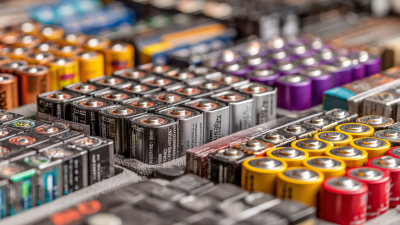Essential Guide to UN3480 Lithium Ion Batteries: Understanding Global Regulations and Safety Standards
In recent years, the global usage of UN3480 lithium ion batteries has seen an unprecedented surge, with the market expected to reach $129 billion by 2027, according to a report by Allied Market Research. This growth underscores the critical need for understanding the associated regulations and safety standards governing their transport and use. With the IATA and other entities continuously evolving guidelines to mitigate risks, it becomes essential for stakeholders—ranging from manufacturers to end-users—to stay informed about compliance requirements. This guide delves into the intricacies of UN3480 lithium ion batteries, exploring the regulatory landscape that ensures safety in their transportation, and providing essential tips for navigating these complex requirements effectively.
Understanding UN3480: What it Means for Lithium Ion Batteries
Understanding UN3480 is crucial for anyone involved in the manufacturing, shipping, or handling of lithium-ion batteries. The UN3480 designation refers to lithium-ion batteries that are shipped as standalone units, which means they aren't contained within or packed with equipment. Recognizing the implications of this classification helps ensure compliance with global transport regulations, particularly the International Air Transport Association (IATA) and the U.S. Department of Transportation.
Tip: Always ensure your lithium-ion batteries are properly labeled with the UN3480 code to avoid shipping delays or penalties. It's essential to check the packaging requirements, including the use of appropriate materials that can withstand potential impacts during transportation.
Furthermore, understanding the safety standards associated with UN3480 is vital for reducing risks associated with battery transport. These standards require that batteries meet specific performance metrics and are packaged in a way that minimizes the chance of short circuits, leakage, and catastrophic failure.
Tip: Conduct regular training sessions for your staff on handling and shipping lithium-ion batteries. This not only boosts safety but also fosters a culture of responsibility and compliance within your organization.
Key Global Regulations Governing Lithium Ion Batteries Transport
Understanding the global regulations surrounding the transport of lithium-ion batteries is crucial for compliance and safety. Recent updates from international bodies emphasize the necessity of adhering to IATA regulations, which mandate that all lithium battery shipments be appropriately labeled. This ensures the safe handling of these potentially hazardous materials across air, road, rail, and marine transport.

Tips: Always check the latest IATA manuals before shipping, as they are continuously updated to reflect the newest safety standards. It’s also advisable to engage with logistics experts familiar with local regulations tailored to lithium battery transport in regions such as the US, Europe, and Asia.
Another critical aspect of battery regulation involves comprehensive life cycle management. The latest initiatives aim to ensure that batteries are manufactured, reused, and recycled safely and sustainably. As the industry pivots toward lower-carbon investments, adherence to these emerging standards will be essential in mitigating the risks associated with battery transport and ensuring environmental compliance.
Tips: Stay informed about regulatory changes and consider participating in workshops or conferences to understand the implications for your business model. Engaging in discussions about lithium battery risks can also enhance your operational safety and compliance strategies.
Safety Standards: Ensuring Compliance with UN3480 Requirements
Lithium-ion batteries, categorized under UN3480, are essential components in various electronic devices and electric vehicles. However, their transport poses distinct safety risks, necessitating stringent safety standards to ensure compliance with international regulations. These safety standards are designed to mitigate hazards such as overheating, short circuits, and potential fire risks during transit. Adhering to these guidelines is critical not only for the safety of shipping personnel but also for protecting the supply chain integrity.

Regulatory bodies globally have established specific protocols for packaging, labeling, and documentation related to UN3480 lithium-ion batteries. Proper packaging must include materials that can withstand punctures and thermal incidents while labeling needs to be clear about the contents and associated hazards. Furthermore, companies must stay updated on compliance requirements, as regulations can evolve in response to new safety data. An effective compliance strategy isn't just about meeting legal obligations; it reflects a commitment to safety and responsibility in the transportation of potentially hazardous materials.
Best Practices for Packaging and Marking UN3480 Batteries
When it comes to packaging and marking UN3480 lithium-ion batteries, adhering to best practices is crucial to ensure safety and compliance with global regulations. Proper packaging can prevent damage during transport, reducing the risk of short circuits and fires. Always use packaging materials that are specifically designed for lithium-ion batteries, such as UN-certified boxes, which provide adequate protection and meet regulatory requirements.
Tip: Ensure that each battery is individually packed using non-conductive materials, like bubble wrap or foam, to prevent direct contact with other batteries and potential short-circuiting. Double-check that the outer packaging is securely sealed and labeled appropriately, with handling and hazard symbols clearly visible.
Labeling is another essential aspect of compliance. Make sure to include the UN3480 marking on the packaging, along with handling instructions. Using clear and concise labels can significantly reduce the risk of accidents during shipping.
Tip: Incorporate additional hazard warnings and instructions in multiple languages, if necessary, to cater to international shipments. This not only aids in regulatory compliance but also enhances overall safety by ensuring that all involved parties understand the necessary precautions.
Navigating Customs and Shipping Procedures for Lithium Ion Batteries
Shipping lithium-ion batteries, particularly those classified under UN3480, requires navigating a maze of customs regulations and safety standards to ensure compliance and safety. According to the International Air Transport Association (IATA), in 2022, 80% of the global air cargo traffic relied on the proper certification of hazardous materials, which included lithium batteries. Failing to adhere to these regulations can lead to severe penalties and shipping delays, making it essential for shippers to stay informed.
**Tip:** Always ensure that lithium-ion batteries are correctly labeled and packaged according to the latest guidelines from organizations like IATA and the International Civil Aviation Organization (ICAO). This reduces the risk of non-compliance during customs inspections.
In addition to packaging, understanding the specific customs procedures for each destination country is crucial. A report from the World Customs Organization (WCO) indicates that improper customs declarations accounted for over 25% of shipping delays for hazardous goods. This emphasizes the importance of accurate documentation and reporting of battery specifications, weights, and quantities.
**Tip:** Utilize a comprehensive checklist to verify that all required documentation, such as the Declaration for Dangerous Goods, is complete and accurate before shipping to ensure smooth transit through customs.
Essential Guide to UN3480 Lithium Ion Batteries: Understanding Global Regulations and Safety Standards
| Regulation/Standard |
Region |
Key Requirements |
Documentation |
Shipping Method |
| UN3480 Compliance |
Global |
Must meet UN Test Series 38.3 |
Safety Data Sheet, Declaration of Dangerous Goods |
Air, Land, Sea |
| IATA DGR |
International |
Battery marking, packaging requirements |
Shipper's Declaration |
Air Freight |
| ICAO TI |
International |
Comprehensive requirements for air transport |
Transport document |
Air Transport Only |
| DOT Regulations |
USA |
Packaging, labeling, and performance testing |
Bill of Lading |
Ground Transport |
| ADR/RID |
Europe |
Specific packaging and marking requirements |
Transport documents |
Road and Rail |












